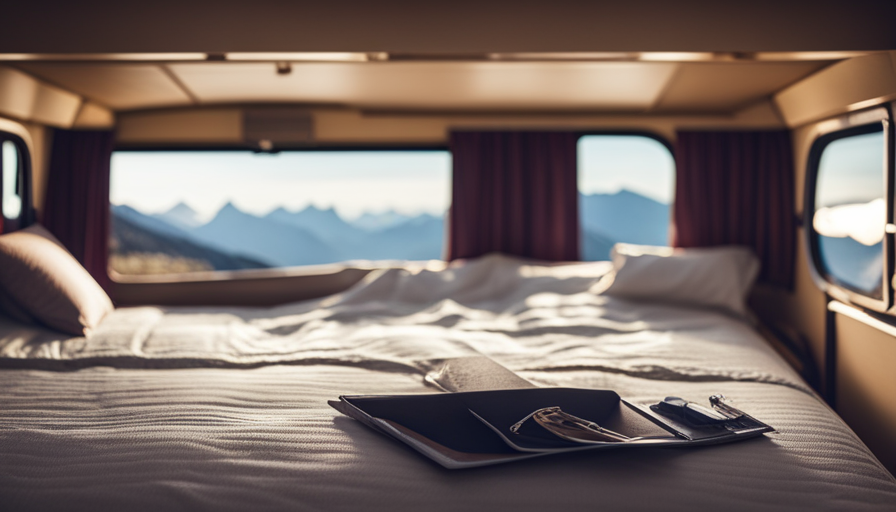Have you ever thought about the clever design behind the simple cassette toilet in a camper? Join me as we explore how practicality and ease come together in this innovative system. Dive into the world of camper toilets!
Picture this: you’re on a road trip with your loved ones, exploring breathtaking landscapes and immersing yourself in the beauty of nature. But, as nature calls, you realize the absence of traditional plumbing can pose a challenge. Fear not, for the cassette toilet is here to save the day!
In this article, we will delve into the world of portable toilet systems, specifically focusing on the cassette toilet. From its components to its working mechanism, we will leave no stone unturned.
Discover the numerous benefits of having a cassette toilet in your camper, from its ease of use to its compact design. We’ll also provide you with essential tips on maintenance and cleaning, ensuring your toilet remains in pristine condition.
So, join us as we unravel the wonders of the cassette toilet, and gain a deeper understanding of this essential camping companion.
Key Takeaways
- Cassette toilets are popular among campers and RV enthusiasts as portable toilet alternatives.
- They are compact, lightweight, and easy to install, making them a convenient solution for bathroom needs while on the road.
- Cassette toilets are environmentally friendly, minimizing water usage and offering an odorless design.
- Maintenance and cleaning are easy with detachable cassettes, and regular cleaning and disinfection ensure longevity.
Overview of Portable Toilet Systems
So, you’re out exploring in your camper and need to take care of business – that’s where a cassette toilet comes in handy! When it comes to portable toilet alternatives, the cassette toilet is a popular choice among campers and RV enthusiasts.
Unlike traditional flush toilets, cassette toilets are compact, lightweight, and easy to install. They offer a convenient and hygienic solution for your bathroom needs while on the road.
One popular alternative to cassette toilets is composting toilets. These toilets use the natural process of decomposition to break down waste into compost. While composting toilets are eco-friendly and don’t require water or chemicals, they do require regular maintenance and can have a distinct odor.
On the other hand, cassette toilets are self-contained systems that use a removable waste cassette for easy disposal. They are odor-free and can be emptied at designated waste disposal stations.
Now, let’s take a closer look at the components of a cassette toilet.
Components of a Cassette Toilet
To fully understand the components of this convenient feature, imagine yourself stepping inside your home-on-wheels and discovering that 90% of the bathroom’s functionality is seamlessly integrated into one compact unit. That’s exactly what a cassette toilet offers in a camper.
Among the various portable toilet options available, cassette toilets stand out for their numerous advantages.
The main components of a cassette toilet include a toilet bowl, a water supply system, a waste holding tank, and a flushing mechanism. The toilet bowl is designed to be comfortable and user-friendly, while the water supply system provides water for flushing and ensures proper hygiene. The waste holding tank is located beneath the toilet bowl and is easily removable for emptying.
One of the major advantages of a cassette toilet is its portability. The compact design allows it to be easily transported and installed in different parts of the camper. Moreover, cassette toilets are often equipped with indicators that show the level of waste, making it convenient to know when it needs to be emptied.
Now that we’ve explored the components of a cassette toilet, let’s delve into how this innovative system works and ensures a hassle-free bathroom experience in your camper.
How a Cassette Toilet Works
The flushing mechanism of a cassette toilet is a crucial component that ensures cleanliness and hygiene in a camper. It operates by releasing a controlled amount of water to flush away waste and keep the toilet bowl clean.
The waste disposal process of a cassette toilet involves emptying the waste tank, which is conveniently located in the camper, into a designated waste disposal area. This process is simple and efficient, ensuring a hassle-free experience for campers.
Flushing Mechanism
Imagine yourself in a camper, where you can effortlessly flush waste using the convenient cassette toilet. The flushing mechanism in a cassette toilet is designed to efficiently and effectively remove waste from the bowl. When you press the flush button, a small amount of water is released from the water tank. This water mixes with the waste, creating a slurry that is then transported to the waste cassette.
The flushing process ensures that the waste is thoroughly flushed away, leaving the bowl clean and odor-free. The cassette toilet’s design minimizes water usage, making it an environmentally friendly option for campers.
Now, let’s move on to the waste disposal process, where the waste cassette can be emptied and cleaned for future use.
Waste Disposal Process
As you step into the realm of waste disposal, a world of managing the aftermath awaits you. When it comes to cassette toilets in campers, the waste disposal process plays a crucial role.
Unlike traditional flush toilets, cassette toilets do not use water for waste disposal. Instead, they utilize portable toilet alternatives such as dry composting toilets. These toilets use natural decomposition processes to break down waste into compost, which can then be safely disposed of. This innovative and eco-friendly system not only eliminates the need for water, but also reduces odor and minimizes the environmental impact.
With composting toilets, waste is transformed into a valuable resource, making them an excellent choice for those seeking sustainable and efficient waste management solutions.
Moving forward, let’s explore the benefits of a cassette toilet and why it’s a popular choice for campers.
Benefits of a Cassette Toilet
You’ll love the convenience and easy maintenance of a cassette toilet in your camper. One of the major benefits of a cassette toilet is its odorless design. Unlike traditional toilets, which can emit unpleasant smells, a cassette toilet utilizes a sealed cassette system that prevents odors from escaping. This means you can enjoy a fresh and clean environment in your camper, even while using the toilet.
Another advantage of a cassette toilet is its compact design. These toilets are specifically designed to fit seamlessly into the limited space of a camper. They’re typically smaller and more lightweight than traditional toilets, making them a perfect choice for mobile living. With a cassette toilet, you can maximize the available space in your camper without sacrificing comfort or functionality.
Maintenance and cleaning of a cassette toilet are also a breeze. The waste is stored in a detachable cassette, which can be easily emptied and cleaned. Some cassette toilets even have indicators that show when it’s time to empty the cassette, making the process even more convenient. Regular cleaning and disinfection will keep your cassette toilet in top condition and ensure its longevity.
Transitioning into the next section about maintenance and cleaning tips, it’s important to know how to properly care for your cassette toilet to maximize its lifespan and continue enjoying its benefits.
Maintenance and Cleaning Tips
To keep your portable restroom in tip-top shape, make sure to regularly maintain and clean it, ensuring a fresh and inviting experience for all. Here are some maintenance tips and cleaning techniques to help you with the upkeep of your cassette toilet:
-
Empty the waste cassette regularly: To prevent odors and maintain hygiene, it’s important to empty the waste cassette frequently. Follow the manufacturer’s instructions on how to remove and empty it properly.
-
Clean the toilet bowl: Use a mild, non-abrasive cleaner and a toilet brush to clean the bowl. Make sure to reach all areas, including under the rim and inside the trap.
-
Deodorize the cassette: After emptying the waste cassette, rinse it thoroughly and add a deodorizing fluid or tablet. This’ll help control odors and keep the cassette smelling fresh.
Regular maintenance and cleaning of your cassette toilet will ensure its longevity and functionality. By following these tips, you can enjoy a clean and comfortable experience while on your camping adventures.
Now that you know how to maintain and clean your cassette toilet, let’s move on to the next section and discuss how to choose the right cassette toilet for your needs.
Choosing the Right Cassette Toilet for Your Needs
Discover the perfect portable restroom that caters to all your specific needs and provides an unmatched level of comfort and convenience.
When it comes to choosing the right cassette toilet for your camper, there are several important factors to consider. First, think about the size of your camper and the number of people who’ll be using the toilet. Portable toilets come in various sizes, so it’s important to find one that fits comfortably in your space.
Next, consider the features that are important to you. Some cassette toilets have built-in water tanks and flushing systems, while others require manual water filling and use a hand pump for flushing. Additionally, you may want to choose a toilet with a removable waste tank for easier cleaning and emptying.
Finally, think about the overall durability and quality of the toilet. Look for a reputable brand that’s known for producing reliable and long-lasting products. By considering these factors, you can find the perfect portable toilet that meets all your needs.
Now, let’s move on to the installation and set-up process.
Installation and Set-Up Process
Get ready to transform your portable restroom experience by diving into the easy and hassle-free installation and set-up process of a cassette toilet. With a cassette toilet, you have a variety of portable toilet options to choose from, making it a popular choice for campers and RV enthusiasts. But how does it compare to a composting toilet? Let’s explore the installation process and find out.
-
Choose the perfect spot: Find a suitable location in your camper for the cassette toilet. Make sure it’s easily accessible and provides enough space for comfortable use.
-
Install the toilet: Follow the manufacturer’s instructions to securely install the cassette toilet in place. This typically involves connecting the water supply and waste tank, ensuring proper sealing to prevent leaks.
-
Set up the waste disposal system: One of the advantages of a cassette toilet is its easy waste disposal system. Simply remove the waste tank and empty it at an appropriate waste disposal site. Some models even have indicators to let you know when it’s time to empty.
With the cassette toilet properly installed and set up, you can now enjoy the convenience and comfort it offers.
Transitioning into the next section, let’s address common concerns and troubleshooting tips for your cassette toilet.
Common Concerns and Troubleshooting
Addressing common concerns and troubleshooting tips ensures that you have a worry-free experience with your cassette toilet, allowing you to confidently navigate any potential issues that may arise.
When it comes to troubleshooting tips, one common concern is odor control. To prevent unpleasant smells, make sure to regularly empty and clean the cassette tank. Use recommended chemicals or additives specifically designed for cassette toilets to help control odors. Additionally, ensure that the seals on the cassette toilet are in good condition and properly closed to prevent any leakage.
If you encounter a persistent odor issue, try using a deodorizer or odor eliminator specifically formulated for cassette toilets. These products can help neutralize odors and keep your camper smelling fresh. It’s also important to properly ventilate the bathroom area by opening windows or using a vent fan to promote air circulation.
Another common concern is the cassette toilet not flushing properly. If you’re experiencing this issue, check that the cassette tank is properly connected and securely locked in place. Sometimes, a blockage in the flush tube can also cause poor flushing. Use a flexible brush or a specialized cassette toilet cleaning wand to clear any debris that may be causing the blockage.
Addressing these troubleshooting tips and odor control strategies will ensure that your cassette toilet operates smoothly and efficiently. Next, we will discuss environmental considerations when using a cassette toilet in a camper.
Environmental Considerations
When it comes to environmental considerations in camper toilets, there are two key points to discuss: proper waste disposal and eco-friendly alternatives.
Proper waste disposal is crucial in order to minimize the impact on the environment. This includes following guidelines for disposing of waste at designated facilities and using biodegradable products.
Additionally, exploring eco-friendly alternatives such as composting toilets or low-flush toilets can help reduce water usage and promote sustainable camping practices.
Proper Waste Disposal
To dispose of waste properly in our cassette toilet, simply empty it at designated waste disposal stations along our journey. These stations are conveniently located near campgrounds and rest stops. This ensures that we’re following proper hygiene practices and minimizing any negative impact on the environment.
When emptying the cassette, we take the following steps:
- Remove the cassette from the toilet by releasing the locking mechanism.
- Take the cassette to the designated waste disposal station.
- Empty the contents into the proper receptacle.
By following these steps, we can ensure that waste is disposed of in a sanitary and responsible manner.
In the next section, we’ll explore eco-friendly alternatives to cassette toilets that further minimize our impact on the environment.
Eco-Friendly Alternatives
Looking for a more environmentally friendly option? Check out these eco-friendly alternatives to minimize your impact on the environment!
One popular option is composting toilets. Unlike traditional flush toilets, composting toilets don’t use water to flush waste away. Instead, they use natural processes to break down waste into compost, which can then be safely disposed of or used as fertilizer. Composting toilets are a great choice for campers who want to reduce water consumption and avoid polluting water sources. They’re also easy to maintain and odor-free when used correctly.
With these eco-friendly options, you can enjoy the convenience of a toilet in your camper while also being mindful of the environment.
Moving on to the conclusion and final thoughts, let’s explore some additional considerations for choosing the right toilet for your camper.
Conclusion and Final Thoughts
In sum, after considering all the aspects and features of a cassette toilet in a camper, it becomes evident that this innovative solution not only provides convenience and flexibility but also offers a more environmentally friendly alternative for waste management while on the road.
When weighing the pros and cons of a cassette toilet, it is clear that its compact size and portability are major advantages. Unlike traditional flush toilets, cassette toilets don’t require a fixed plumbing system. This flexibility allows campers to easily install and remove the toilet as needed. Additionally, the waste cassette can be easily emptied at designated dumping stations, eliminating the need for complex and expensive sewage systems.
Comparing cassette toilets to other toilet systems, it’s important to note that composting toilets can also be considered eco-friendly alternatives. However, composting toilets require more maintenance and space, making them less suitable for smaller campers. Additionally, chemical toilets, while portable, often use harsh chemicals that can be harmful to the environment.
A cassette toilet in a camper offers a practical solution for waste management while on the road. Its compact size, portability, and ease of use make it a convenient choice for campers. Furthermore, its eco-friendly design and the ability to easily dispose of waste make it a greener option compared to traditional flush toilets or chemical toilets.
Overall, a cassette toilet provides campers with a reliable and environmentally conscious way to address their sanitation needs.
Frequently Asked Questions
Can a cassette toilet be used in extreme temperatures?
In freezing temperatures, using a cassette toilet can be a challenge. However, with proper precautions, it’s possible to maintain functionality. To prevent freezing, it’s crucial to insulate the cassette and keep it warm. Additionally, using antifreeze additives in the flush water can help prevent any damage caused by freezing temperatures.
In hot climates, maintaining a cassette toilet involves proper ventilation and regular cleaning to avoid unpleasant odors.
How often should the cassette tank be emptied?
We recommend emptying the cassette tank of a cassette toilet in a camper every 2-3 days, or when it reaches two-thirds full. Regular cleaning is essential to maintain hygiene and prevent odors.
Using a cassette toilet in a camper offers several benefits. It provides a convenient and private bathroom solution while on the road, eliminates the need to find public restrooms, and allows for more flexibility in choosing camping locations.
Can a cassette toilet be used while the camper is in motion?
Yes, a cassette toilet can be used while the camper is in motion. Using a cassette toilet while camping offers numerous benefits. It provides convenience and eliminates the need to find public restrooms. The compact design of the cassette toilet allows for easy installation and usage. Its portable nature makes it ideal for camping trips. So, whether you’re on the move or parked at a scenic spot, a cassette toilet is a reliable and practical choice.
Are cassette toilets suitable for individuals with mobility issues?
Cassette toilets are highly suitable for individuals with mobility issues due to their accessibility features. These toilets are designed to be easily accessed and used by people with limited mobility, offering convenience and independence.
The benefits of cassette toilets for mobility-impaired individuals include their compact size, ease of use, and the ability to be installed at a suitable height. Additionally, these toilets are equipped with grab handles and support bars to ensure stability and safety while using them.
Can chemicals be used in a cassette toilet to reduce odors?
Yes, chemicals can be used in a cassette toilet to reduce odors. However, there are also chemical-free options available that provide numerous benefits. These options use natural enzymes to break down waste and eliminate odors, making them more environmentally friendly. Additionally, they’re safer for individuals with mobility issues as they don’t require handling or storing harsh chemicals. Using a cassette toilet with chemical-free options ensures a cleaner, more pleasant camping experience.
Conclusion
In conclusion, the cassette toilet is a game-changer for campers and outdoor enthusiasts. It’s compact design and easy installation make it a convenient option for those seeking a portable toilet system. The juxtaposition of its simplicity and effectiveness is what truly sets it apart.
With its efficient waste management and low maintenance requirements, the cassette toilet provides a hassle-free experience while preserving the environment. So, if you’re looking for a practical and reliable solution for your camping adventures, the cassette toilet is definitely worth considering.











